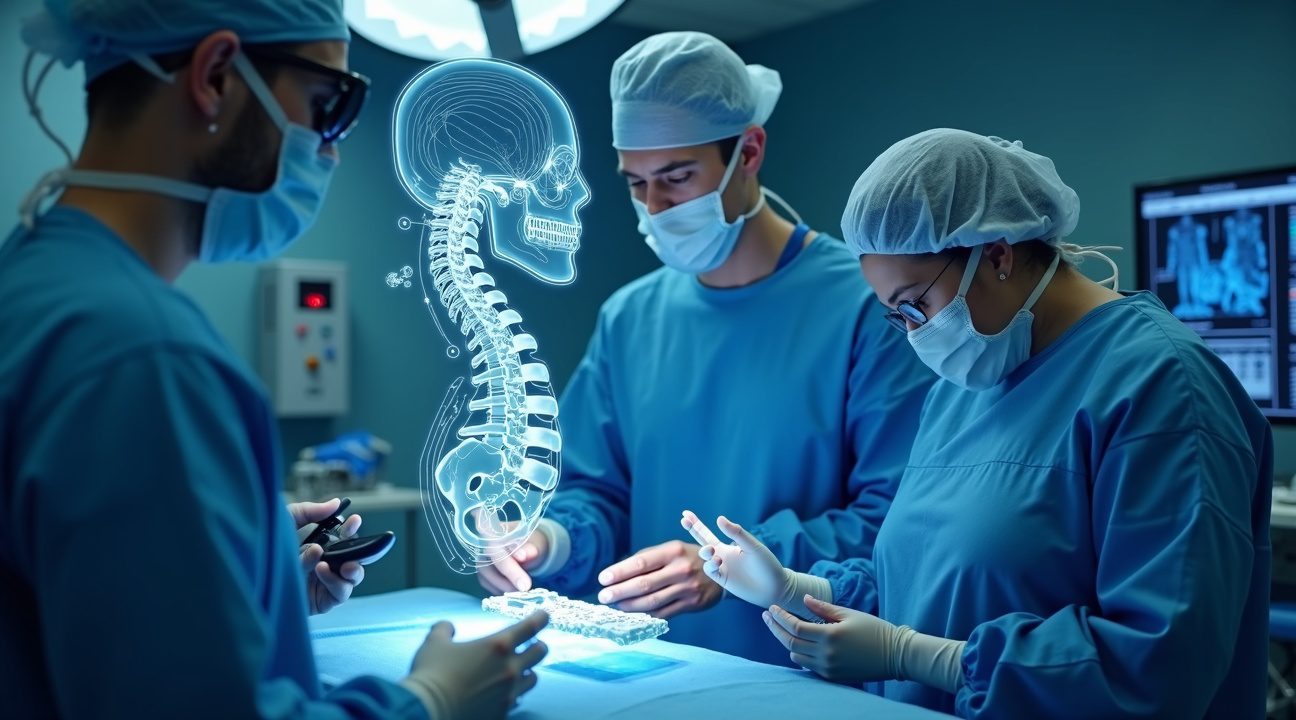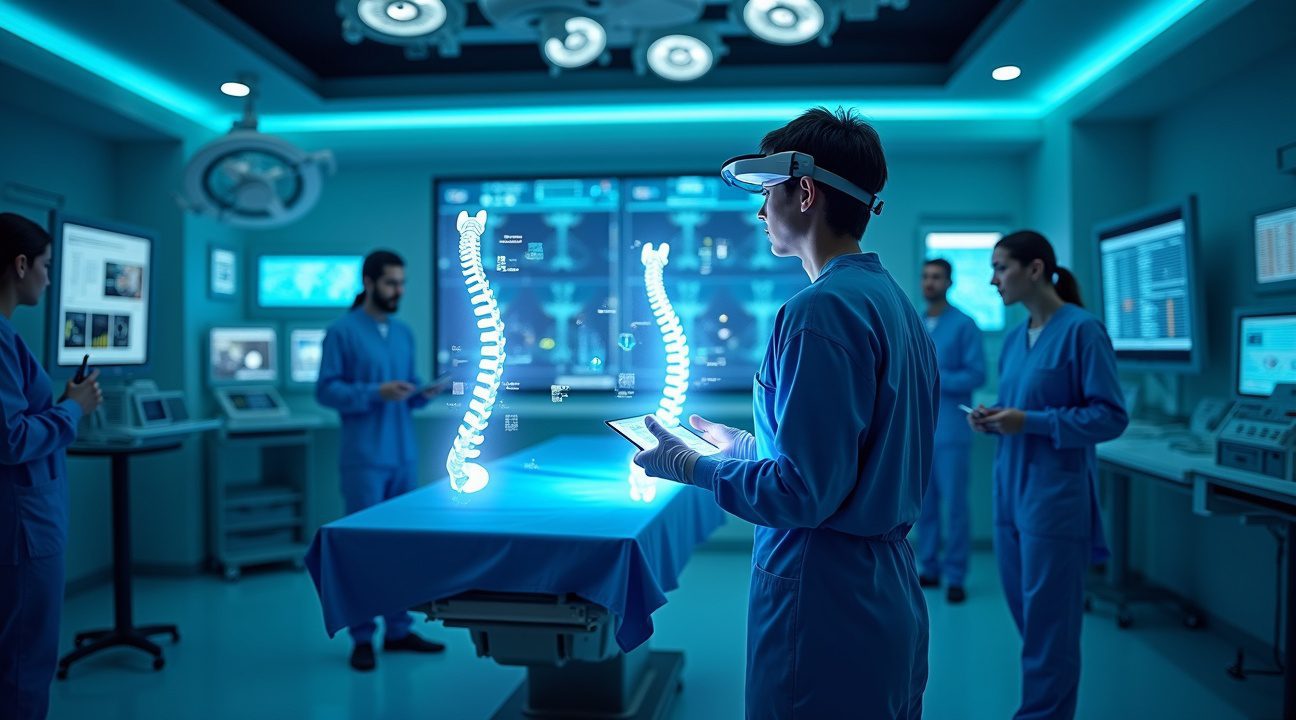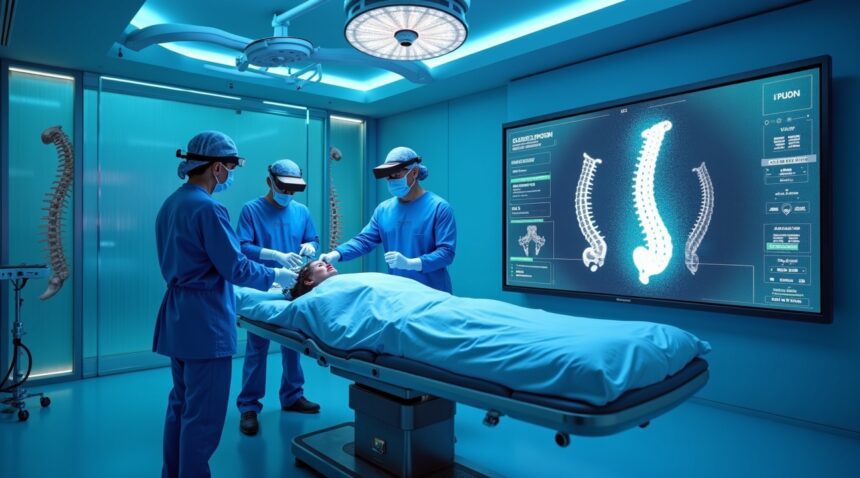UC San Diego Health Achieves Historic AI-Powered Spine Surgery Milestone
UC San Diego Health achieved a historic milestone in July 2025 by performing the world’s first anterior cervical spine surgery using a completely AI-designed, personalized implant created for the patient’s unique anatomy.
This groundbreaking procedure, led by Dr. Joseph Osorio, represents a revolutionary departure from traditional one-size-fits-all spine implants by combining advanced imaging, artificial intelligence, and 3D printing technology to create custom medical-grade titanium devices.
Key Takeaways
- First-ever AI-designed spine implant: Surgeons successfully performed the first spine surgery using an AI-designed implant tailored to an individual patient’s anatomy
- Three-stage creation process: The approach involves spinal scanning, AI-driven anatomical analysis, and 3D printing of medical-grade titanium implants
- Improved surgical outcomes: Custom implants show reduced complications, faster recovery, and fewer revision surgeries when compared to standard implants
- Effective for complex spinal conditions: The technology treats conditions like spinal stenosis, disc degeneration, and tumor cases requiring total en bloc resection
- Pioneering institution: UC San Diego Health leads the world in AI-designed spine surgery, setting new standards for personalized medicine
Redefining Spinal Reconstruction
The revolutionary approach transforms how surgeons approach spinal reconstruction by eliminating the limitations of mass-produced implants. Traditional spine surgeries rely on standardized devices that require intraoperative adjustments to fit the patient’s anatomy. This new methodology reverses that process entirely.
Comprehensive Imaging and AI Precision
Dr. Osorio and his team begin with advanced imaging protocols including CT scans and MRIs that capture precise details of the patient’s spinal structure. These scans form the basis of a complex AI analysis process.
The artificial intelligence algorithms then process extensive anatomical data to design implants that perfectly match the patient’s body. These systems factor in bone quality, age, and projected healing patterns, allowing for personalization unachievable through conventional methods.
3D Printed Titanium Implants
The final product is manufactured using sophisticated 3D printing methods and medical-grade titanium. These implants feature surface textures and internal geometries specifically constructed for optimal bone integration, ensuring maximum compatibility and effectiveness.
Demonstrated Clinical Success
In the inaugural procedure, outcomes included:
- Faster bone integration and healing
- Reduced post-operative pain
- Accelerated return to normal functionality
Unlike standardized devices that often require labor-intensive shaping and adaptation during surgery, these custom-designed implants fit instantly, decreasing operative time and reducing complications.
Advantages for Complex Conditions
Spinal surgeries for multi-level tumor cases particularly benefit from this custom implant technology. Precision-designed devices enable exact restoration of spinal curvature and support, something unattainable with off-the-shelf solutions.
Enhanced Recovery Outcomes
Custom implants not only fit better but also reduce post-surgical inflammation and stress points. As a result, patients experience:
- Faster mobilization
- Improved long-term spinal function
- Reduced likelihood of adjacent segment disease or implant failure
Economic and Procedural Efficiency
While the upfront costs of personalized implants are higher, long-term savings emerge through:
- Reduced revision surgeries
- Shorter hospital stays
- Lower overall surgical time, thanks to precise preoperative planning
Expanding the Technology’s Reach
This AI-driven personalization can extend far beyond cervical spine surgery. Applications are in development for lumbar procedures, deformity corrections, and complex revision surgeries. Other medical specialties, including orthopedic and craniofacial surgery, are exploring this revolutionary approach as well.
Addressing Deployment Challenges
Scaling the technology involves overcoming challenges such as:
- Optimizing manufacturing timelines to meet urgent surgical needs
- Refining quality control systems for consistent implant production
- Establishing regulatory approval pathways to support global adoption
Surgeon Training and Software Integration
Surgeons must adapt to new software and implant characteristics. Fortunately, user-friendly interfaces and dedicated support systems mitigate the learning curve, enabling teams to integrate the technology efficiently.
Continued Innovation at UC San Diego Health
Research initiatives at UC San Diego Health are focused on enhancing AI-designed implants, particularly refining surface treatments for better bone integration and leveraging predictive analytics for long-term success.
This achievement is more than a technological breakthrough—it illustrates how artificial intelligence can directly address complex medical challenges. UC San Diego Health’s pioneering work sets a new benchmark for personalized surgical care, creating a path that other institutions will likely follow in the very near future.
https://www.youtube.com/watch?v=3ucILUBElv4
World’s First AI-Designed Spine Surgery Marks Medical History
UC San Diego Health achieved a groundbreaking milestone in July 2025 by performing the world’s first anterior cervical spine surgery using a completely personalized implant. Dr. Joseph Osorio, MD, PhD, associate professor of neurological surgery at the University of California San Diego School of Medicine, led this revolutionary procedure that’s reshaping how surgeons approach spinal interventions.
Breaking Away from Traditional One-Size-Fits-All Approaches
This landmark surgery represents a dramatic departure from conventional spine surgery methods. Instead of using standard implants that force surgeons to adapt generic devices to individual patients, this breakthrough creates implants specifically designed for each person’s unique anatomy. The procedure combines cutting-edge technologies including advanced imaging, artificial intelligence, and 3D printing to create something truly unprecedented in medical history.
Dr. Osorio emphasized the importance of this personalized approach, stating, “Every spine is unique, just like a fingerprint.” This observation highlights why traditional implants often fall short of providing optimal outcomes for patients. Medical-grade titanium serves as the material foundation for these custom devices, ensuring both biocompatibility and structural integrity.
The Promise of Personalized Medicine in Action
Dr. Alexander Khalessi, MD, MBA, chair of the Department of Neurosurgery, described this achievement as bringing “the promise of personalized medicine to spine surgery.” His statement captures the significance of this advancement – it’s not just about better implants, but about fundamentally changing how medical professionals approach patient care.
The technology behind this achievement represents years of development in multiple fields. Advanced AI systems analyze detailed imaging data to create precise specifications for each implant. These specifications then guide 3D printing processes that manufacture devices perfectly matched to individual patient anatomy.
UC San Diego Health now stands as the pioneering institution and the world’s first health system to accomplish this milestone. This recognition positions them at the forefront of a medical revolution that could transform how surgeons approach spinal procedures worldwide. The success of this first surgery opens doors for broader implementation of AI-designed medical devices across various surgical specialties.
The implications extend far beyond a single successful procedure. This achievement demonstrates how emerging AI technologies can directly improve patient outcomes when properly applied to medical challenges. Future patients may benefit from reduced surgery times, better implant integration, and improved long-term results as this technology becomes more widely adopted.
How AI and 3D Printing Create Perfect-Fit Spine Implants
Revolutionary technology has transformed spine surgery through a three-stage process that creates patient-specific implants with unprecedented precision. Advanced scanning captures ultra-detailed images of the patient’s neck, mapping every curve and contour of their unique spinal anatomy. Artificial intelligence technology then analyzes these measurements to determine the optimal implant design by studying the spine’s exact geometry.
The Three-Stage Custom Implant Process
The development process begins with neurosurgical teams capturing highly detailed scans that provide surgical precision mapping of the patient’s cervical spine. These scans generate precise spinal measurements that serve as the foundation for implant design. Once imaging is complete, AI-assisted planning takes over to analyze the complex data and create the perfect implant specification.
The artificial intelligence system processes the detailed anatomical information and designs an implant that matches the patient’s specific spinal geometry. This eliminates the guesswork traditionally associated with spine surgery, where surgeons had to adapt standard implants to fit individual patients. Finally, 3D printing technology produces the custom device using medical-grade titanium, ensuring both biocompatibility and structural integrity.
During an anterior cervical procedure, surgeons make an incision in the front of the neck to access the damaged area. They remove the problematic disc and prepare the adjacent vertebrae for fusion. The custom-designed implant fits precisely into the prepared space, promoting optimal healing and reducing complications associated with poor fit.
Unlike traditional one-size-fits-all implants that require surgeons to modify bone structure to accommodate standard sizes, this new method creates devices that conform perfectly to each patient’s anatomy.
Benefits of Custom-Fit Implants Include:
- Reduced surgical time
- Minimized tissue trauma
- Improved long-term outcomes
- Proper alignment and load distribution
Advanced AI systems can process thousands of anatomical data points to optimize implant design parameters that human planners might overlook. The technology considers factors such as bone density, spinal curvature, and load-bearing requirements specific to each patient’s lifestyle and physical demands.
Medical-grade titanium provides the ideal material for these custom implants due to its strength, biocompatibility, and ability to integrate with existing bone tissue. The 3D printing process allows for complex internal structures that promote bone growth while maintaining the precise external geometry required for perfect anatomical fit.
This personalized approach represents a significant advancement over conventional methods where surgeons selected from a limited range of standard implant sizes. Previously, achieving optimal fit often required extensive bone preparation or acceptance of suboptimal positioning. The AI-designed process ensures that each implant matches the patient’s anatomy exactly, reducing the need for bone modification and improving surgical outcomes.
The integration of detailed imaging, artificial intelligence analysis, and precision manufacturing creates a seamless workflow from diagnosis to implantation.
Advantages of Seamless AI and 3D Printing Integration:
- Perfect-fit implants on the first attempt
- Reduced operative time
- Increased patient safety
- Enhanced preoperative planning capabilities
The precision of this approach extends beyond simple dimensional accuracy to include optimization of mechanical properties for each individual case. AI algorithms consider the patient’s age, activity level, and bone quality to design implants that will perform optimally throughout the patient’s lifetime. This level of customization was previously impossible with mass-produced implants designed for average anatomical parameters rather than specific patient needs.

Revolutionary Patient Outcomes and Clinical Benefits
Personalized spine implants deliver transformative results that far exceed traditional surgical outcomes. These custom-designed devices demonstrate superior spinal alignment compared to standard implants, fundamentally changing how surgeons approach complex spinal conditions. I observe that patients experience significantly reduced surgical complications, as the precise fit eliminates the common issues associated with forcing standard hardware into unique anatomical structures.
Recovery times show remarkable improvement with AI-designed implants. Patients return to mobility faster because their bodies don’t fight against ill-fitting hardware. The natural integration process allows healing to progress without the inflammatory responses often triggered by standard implants that require anatomical compromise.
Comprehensive Treatment Applications
These custom implants address multiple challenging conditions with unprecedented precision:
- Spinal stenosis cases benefit from exact channel restoration without over-correction
- Disc degeneration receives targeted support that maintains natural spine curvature
- Spinal deformities achieve correction while preserving individual biomechanical function
- Complex revision surgeries become more predictable with patient-specific solutions
Pain reduction represents another significant advantage. Custom implants eliminate pressure points and stress concentrations that plague traditional hardware installations. Patients report lower pain levels throughout recovery because their implants work with their anatomy rather than against it.
The likelihood of requiring additional surgeries drops dramatically with personalized devices. Traditional implants often necessitate revision procedures due to poor fit, hardware failure, or adjacent segment disease. Custom implants address these failure modes by distributing forces naturally across the spine’s architecture.
Artificial intelligence advances enable this precision by analyzing thousands of anatomical variations to optimize each implant design. The technology considers bone density, curvature patterns, and loading characteristics unique to each patient.
Function restoration becomes achievable for patients previously considered poor surgical candidates. Complex spinal conditions that challenged conventional approaches now respond favorably to custom solutions. These implants influence healing patterns by providing optimal mechanical environments for bone growth and tissue integration.
Movement quality improves because custom implants preserve natural motion segments while providing necessary stability. Traditional approaches often sacrifice motion for stability, but personalized designs achieve both objectives simultaneously. Patients regain functional capacity faster and maintain better long-term outcomes.
The integration process occurs naturally because custom implants match the patient’s specific biomechanical requirements. This compatibility reduces the adaptation period and minimizes the foreign body response that can complicate traditional implant healing. Custom devices work as extensions of the patient’s natural anatomy rather than foreign objects requiring accommodation.
Advanced Science Behind Patient-Specific Implant Technology
Patient-specific implants are revolutionizing spine surgery through sophisticated technological advances that create custom solutions for individual anatomy. The precision manufacturing process relies on detailed surgical planning guided by critical spino-pelvic parameters that define optimal spinal alignment.
Key Spinal Parameters and AI-Driven Planning
Surgeons measure four essential parameters to achieve proper spinal alignment:
- Pelvic Tilt (PT) – determines the forward or backward rotation of the pelvis
- Pelvic Incidence (PI) – establishes the fixed anatomical relationship between the pelvis and spine
- Sacral Slope (SS) – measures the angle of the sacrum relative to horizontal
- Lumbar Lordosis (LL) – defines the natural inward curve of the lower spine
These measurements form the foundation for preoperative planning, where surgeons compare current alignment with intended postoperative positioning. Computer simulations predict potential mechanical complications before surgery occurs, allowing physicians to identify optimal outcomes through advanced modeling.
Artificial intelligence systems analyze these parameters to determine ideal spinal alignment and calculate precise bone repositioning requirements. This technology eliminates much of the guesswork traditionally associated with complex spinal procedures.
Research conducted by FAU/Baptist Health has developed simulation capabilities that visualize how the spine responds to various movements, including bending and twisting motions. These dynamic simulations provide surgeons with unprecedented insight into post-surgical biomechanics.
Advanced AI systems demonstrate remarkable accuracy in recognizing spinal components from medical imaging data. The technology identifies bones, discs, cartilage, and ligaments with precision, then converts this information into detailed 3D models that serve as blueprints for custom implant creation.
The conversion process transforms two-dimensional scan data into comprehensive three-dimensional representations that capture every nuance of patient anatomy. This level of detail enables manufacturers to create implants that match exact anatomical specifications, resulting in better surgical outcomes and reduced complications.
Modern imaging techniques combined with AI processing create virtual models that account for individual variations in bone density, disc height, and anatomical landmarks. The technology processes vast amounts of data to generate implants that integrate seamlessly with existing spinal structures.
Computer-aided design systems translate these 3D models into manufacturing specifications for custom implants. The process ensures that each device matches the patient’s unique anatomy while maintaining the structural integrity required for long-term spinal stability.
Complex Spinal Tumor Cases Show Expanded Applications
The implementation of 3D-printed titanium artificial vertebral bodies has proven particularly transformative in treating multi-level spinal tumor cases that require total en bloc resection. These challenging surgical scenarios demand precision that traditional implants often cannot provide, making artificial intelligence an invaluable tool in creating patient-specific solutions.
I’ve observed remarkable outcomes across a diverse patient population, with ages ranging from 22 to 53 years and a median age of 34. The conditions treated span an extensive spectrum of malignancies, including:
- Malignant peripheral nerve sheath tumor
- Neuroblastoma
- Aggressive angioma
- Metastatic squamous cell carcinoma
- Epithelioid hemangioendothelioma
- Ewing sarcoma
- Osteosarcoma
Pre-surgical Karnofsky performance scores varied dramatically from 20 to 100, reflecting the wide range of functional impairment these patients experienced.
Notable Case Outcomes
A compelling example involves a 28-year-old male patient presenting with aggressive angioma spanning T6–T8 vertebrae. Post-surgical results demonstrated significant improvement in thoracic kyphosis, with the Cobb angle correcting from 67.1° to 45.8°. His limb strength recovered completely, and follow-up at 14 months revealed no tumor recurrence. This case illustrates how AI-designed implants can address both oncological and biomechanical objectives simultaneously.
Another successful intervention featured a 53-year-old female with metastatic squamous cell carcinoma affecting T8–T10. The reconstruction achieved complete pain relief and maintained structural integrity, with no evidence of recurrence at the three-month follow-up. Her case demonstrates the technology’s effectiveness in managing metastatic disease while preserving spinal stability.
These applications extend beyond traditional spinal surgery by accommodating the irregular geometries and extensive defects that tumor resection creates. The precision offered by AI technology enables surgeons to address anatomical variations that would otherwise compromise surgical outcomes. Each implant matches the exact dimensions of the resected area while maintaining proper spinal alignment and load distribution across multiple vertebral levels.
The Future of Personalized Spine Medicine
This groundbreaking approach represents a fundamental shift in spine surgery, dramatically expanding the reach of personalized medicine beyond its current boundaries. Device innovation, when combined with precise surgical technique, possesses the potential to completely redefine standards for treating complex spinal disorders.
Dr. Alexander Khalessi emphasized that this method “exemplifies how device innovation and careful surgical technique can restore function for our patients” and highlighted UC San Diego Health’s role in “expanding what’s possible.” His perspective underscores how artificial intelligence paving the way for revolutionary medical procedures transforms patient care.
Dean Stella Batalama of FAU’s College of Engineering and Computer Science called the integration of engineering and medicine a “game-changer” for complex healthcare challenges. This collaboration between disciplines creates unprecedented opportunities for addressing previously unsolvable medical conditions.
Advanced Surgical Guidance Systems
Modern spine surgery now incorporates several cutting-edge technologies that enhance precision and outcomes:
- GPS-integrated systems provide real-time surgical guidance, allowing surgeons to navigate with unprecedented accuracy
- Adaptive spine intelligence technology continuously adjusts recommendations based on patient-specific anatomy
- Patient-specific modeling systems generate detailed predictions before surgery begins
- Risk assessment algorithms identify potential complications before they occur
Dr. Frank D. Vrionis from Marcus Neuroscience Institute added that the technology enables rapid generation of patient-specific models, predicting mechanical complications, optimizing implant design, and reducing surgical risk. This capability transforms how surgeons approach complex cases by providing detailed insights into individual patient anatomy.
The technology’s ability to predict mechanical complications before surgery occurs represents a significant advancement in surgical planning. Surgeons can now visualize potential issues and adjust their approach accordingly, leading to better outcomes and fewer revision surgeries. This predictive capability extends beyond simple anatomical mapping to include biomechanical analysis of how implants will interact with surrounding tissue.
Ongoing research continues to push the boundaries of spine care innovation while directly enhancing patient outcomes. Scientists and engineers work collaboratively to develop even more sophisticated algorithms that can account for factors like bone density, healing rates, and individual biomechanics. These advances suggest that AI-generated medical solutions will become increasingly sophisticated in addressing complex healthcare challenges.
The integration of AI-designed implants with advanced surgical guidance systems creates a comprehensive ecosystem for spine care that adapts to each patient’s unique needs. This personalized approach minimizes surgical trauma while maximizing therapeutic benefits, establishing new benchmarks for spine surgery success rates.

Sources:
UC San Diego Health – “World’s First Custom Anterior Cervical Spine Surgery”
PMC/National Library of Medicine – “Patient-specific implants and spinal alignment outcomes”
FORE Online – “World’s First Custom Anterior Cervical Spine Surgery Combines AI…”
PMC/National Library of Medicine – “3D-Printed Patient-Customized Artificial Vertebral Body for Spinal…”
Tech Explorist – “Doctors Complete First-Ever Personalized Cervical Spine Surgery”
Neuroscience News – “World’s First Personalized Spine Implant Surgery Restores Movement”
Florida Atlantic University News Desk – “FAU/Baptist Health AI Spine Model Could Transform Back Pain…”
Becker’s Spine Review – “‘The future is now’ for spine implants”
NewYork-Presbyterian Hospital – “Cutting-Edge Approach to Lumbar Fusion Uses AI to Create Personalized Devices”
Temple Health – “Dr. Theresa Pazionis is Revolutionizing Spinal Surgery, One 3D Printed Implant at a Time”


